
Piran or Pyran, died c. 480, was a 5th-century Cornish abbot and saint, possibly of Irish origin. He is the patron saint of tin-miners, and is also generally regarded as the patron saint of Cornwall, although Michael and Petroc also have some claim to this title.

Petroc or Petrock was a British prince and Christian saint.

Combe Raleigh is a village and civil parish in the county of Devon, England. The village lies about 1.5 miles north of the town of Honiton, and the parish is surrounded, clockwise from the north, by the parishes of Luppitt, Honiton, Awliscombe and Dunkeswell.
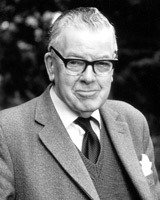
Frederick Fyvie Bruce was a Scottish evangelical scholar, author and educator who was Rylands Professor of Biblical Criticism and Exegesis at the University of Manchester from 1959 until 1978 and one of the most influential evangelical scholars of the second half of the twentieth century. When the academic community looked down upon Evangelicals, Bruce demonstrated that a scholar holding evangelical views could do worthwhile academic work. He persuaded Evangelicals that they should not turn their backs on academic methods of Bible study, even if the results might differ from traditional evangelical views. As a result, he has been called the "Dean of Evangelical Scholarship".

St Mawgan or St Mawgan in Pydar is a village and civil parish in Cornwall, England, United Kingdom. The population of this parish at the 2011 census was 1,307. The village is situated four miles northeast of Newquay, and the parish also includes the hamlet of Mawgan Porth. The surviving manor house known as Lanherne House is an early 16th-century grade I listed building. The nearby Royal Air Force station, RAF St Mawgan, takes its name from the village and is next to Newquay Cornwall Airport. The River Menalhyl runs through St Mawgan village and the valley is known as The Vale of Lanherne. It was the subject of a poem by poet Henry Sewell Stokes.

Newton St Petrock is an ecclesiastical and civil parish in the Torridge district of Devon in England, occupying approximately 1,500 acres (6.1 km2). The parish had a population in 2001 of 163.

St Goran is a coastal civil parish in Cornwall, England, UK, six miles (10 km) south-southwest of St Austell. The largest settlement in the parish is the coastal village of Gorran Haven, a mile to the east with a further cluster of homes at Trevarrick. The population at the 2011 census was 1,411.

St Winifred's Church is a Church of England church in Branscombe in Devon, England. The church is dedicated to Saint Winifred, a Welsh saint. It is among the oldest and most architecturally significant parish churches of Devon. It probably dates back as far as about 995, but extant records on the vicars only go back to the thirteenth century.
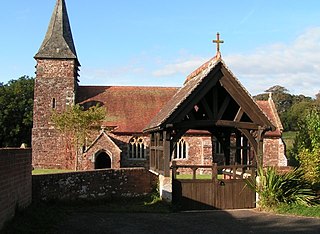
Farringdon is a village, civil parish and former manor in the district of East Devon in the county of Devon, England. The parish is surrounded clockwise from the north by the parishes of Clyst Honiton, Aylesbeare, a small part of Colaton Raleigh, Woodbury, Clyst St Mary and a small part of Sowton.
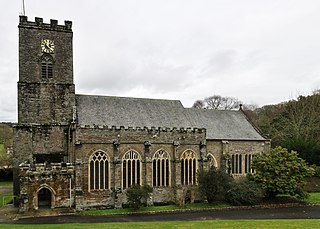
Christianity in Cornwall began in the 4th or 5th century AD when Western Christianity was introduced as in the rest of Roman Britain. Over time it became the official religion, superseding previous Celtic and Roman practices. Early Christianity in Cornwall was spread largely by the saints, including Saint Piran, the patron of the county. Cornwall, like other parts of Britain, is sometimes associated with the distinct collection of practices known as Celtic Christianity but was always in communion with the wider Catholic Church. The Cornish saints are commemorated in legends, churches and placenames.

Various monasteries and other religious houses have existed at various times during the Middle Ages in the city of Exeter, Devon, England.
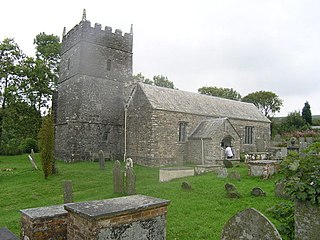
St Petrock's Church in Parracombe, Devon, England was built in the 13th century. It is recorded in the National Heritage List for England as a designated Grade I listed building, and is now a redundant church in the care of the Churches Conservation Trust. It was declared redundant on 25 November 1969, and was vested in the Trust on 23 June 1971.

St Pancras Church is a small church situated in the middle of the Guildhall Shopping Centre in Exeter. The majority of the church dates from the thirteenth century, although the font is eleventh century. The church probably occupies the oldest Christian site in Exeter, and is usually open on weekdays. The church is designated by English Heritage as a Grade II* listed building.
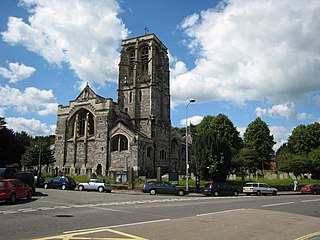
St David's Church, Exeter is a church in Exeter, Devon. It is a Grade I listed building.

St Stephen's Church is a small church in the centre of Exeter. It has a Saxon crypt but the first mention of the church is in the Domesday Book. Its location was formerly opposite the medieval guildhall. In July 2012 it reopened following a major renovation which cost £1.5 million.

The area of Cathedral Close, Exeter has been in the centre of Exeter, Devon, England, since Roman times when there was a basilica and a bath house in this area. A church was established here by the seventh century when a young Saint Boniface came from Crediton to study. The area was walled after 1283 and seven gates into the yard were created. The gates included one at St Petrocks and the original grand entrance into the yard – Broadgate. This created the cathedral close.
William Martyn (1562–1617) was an English lawyer and historian.

Clannaborough is a parish in the county of Devon, England, situated about 5+1⁄2 miles north-west of the town of Crediton and 11 miles north-east of Okehampton. No village exists, only scattered farmhouses, including Clannaborough Barton and the bartons of Appledore and Walson, all three estates listed in the Domesday Book of 1066. Walson was the birthplace of Christopher Lethbridge (d.1670), Mayor of Exeter in 1660, who was lord of the manor of nearby Bow. The parish church is dedicated to St Petrock.

The Church of St Mary Major, formerly Exeter Minster, was a historic church and parish in the City of Exeter, Devon, dating from the 7th century. It pre-dated the first Exeter Cathedral by some five centuries, was rebuilt several times, but was finally demolished in 1971. It was situated to the immediate south-west of Exeter Cathedral, the site today being a grass lawn.


















